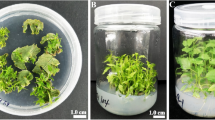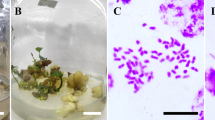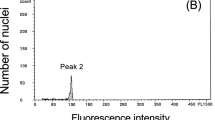Abstract
Polyploids generally show strong environmental adaptation and diverse morphological variations. Therefore, polyploid induction is an important protocol for plant breeding. Lilium rosthornii is a wild lily species with high horticultural value and excellent disease resistance. In this study, seeds of L. rosthornii were subjected to polyploidy induction treatments to obtain multiple genotypes of tetraploids. Germinated seeds were immersed in two antimitotic agents at different concentrations for various times. In total, 199 tetraploid genotypes were obtained. The most efficient treatments of each agent were immersed in 0.05% colchicine for 36 h and in 0.01% oryzalin for 24 h; the induction rate of the former (27.78%) was significantly higher than that of the latter (22.22%). The swollen hypocotyl phenotype after colchicine and oryzalin treatments was strongly correlated with tetraploidy (0.989** and 0.975**, respectively), suggesting that this phenotype could serve as an early ploidy selection trait. The correlations were weaker between stomata length/density and tetraploidy (0.773** and 0.695**, respectively), implying that stomatal characters are affected by both the ploidy level and genotype. After several rounds subculture in vitro, the morphology and growth traits were not significantly different between diploids and tetraploids, but there were wider variations in these parameters in tetraploids than in diploids. After transplanting, the bulblet germination rate was higher in tetraploids than in diploids. The leaf phenotype did not differ between tetraploids and diploids initially, but the leaves of tetraploids became larger than those of diploids over time. Together, these suggest that tetraploids, may contribute diverse characteristics to lily breeding.
Key message
Multiple genotypes of tetraploid Lilium rosthornii were induced by colchicine and oryzalin. Swollen hypocotyl was associated with polyploidy. Compared with diploids, tetraploids showed wider variations in morphological parameters.



Similar content being viewed by others
Abbreviations
- ANOVA:
-
One-way analysis of variance
- BA:
-
Benzylaminopurine
- FCM:
-
Flow cytometry
- MS:
-
Murashige–Skoog
- NAA:
-
Naphthylacetic
References
Acosta-Gallegos JA, Kelly JD, Gepts P (2007) Prebreeding in common bean and use of genetic diversity from wild germplasm. Crop Sci 47(Supplement 3):44–59
Allario T, Brumos J, Colmenero-Flores JM et al (2011) Large changes in anatomy and physiology between diploid Rangpur lime (Citrus limonia) and its autotetraploid are not associated with large changes in leaf gene expression. J Exp Bot 62:2507–2519
Aqafarini A, Lotfi M, Norouzi M et al (2019) Induction of tetraploidy in garden cress: morphological and cytological changes. Plant Cell Tissue Organ Cult 37:627–635
Ascough GD, Staden JV (2008) Effectiveness of colchicine and oryzalin at inducing polyploidy in Watsonia lepida N.E Brown. HortScience 43:2248–2251
Aversano R, Caruso I, Aronne G et al (2013) Stochastic changes affect Solanum wild species following autopolyploidization. J Exp Bot 64:625–635
Bajer A, Mole-Bajer J (1986) Drugs with colchicine-like effects that specifically disassemble plant but not animal microtubules. Ann N Y Acad Sci 466:767–784
Barba-Gonzalez R, Miller C, Ramanna M et al (2006) Induction of 2n gametes for overcoming F1-sterility in lily and tulip. In: XXII international Eucarpia symposium, section ornamentals, breeding for beauty 714, pp 99–106
Bingham E, Groose R, Woodfield D et al (1994) Complementary gene interactions in alfalfa are greater in autotetraploids than diploids. Crop Sci 34:823–829
Bouvier L, Fillon FR, Lespinasse Y (2010) Oryzalin as an efficient agent for chromosome doubling of haploid apple shoots in vitro. Plant Breed 113:343–346
Cao Q, Zhang X, Gao X et al (2018) Effects of ploidy level on the cellular, photochemical and photosynthetic characteristics in Lilium FO hybrids. Plant Physiol Biochem 133:50–56
Chen R, Jiang WZ, Li QL et al (2016) Comparison of seven colchicine-induced tetraploid clones with their original diploid clones in purple coneflower (Echinacea purpurea L.). Euphytica 207:387–399
Chung MY, King CY, Min JS et al (2014) In vitro induction of tetraploids in an interspecific hybrid of Calanthe (Calanthe discolor x Calanthe sieboldii) through colchicine and oryzalin treatments. Plant Biotechnol Rep 8:251–257
Dar TH, Raina SN, Goel S (2013) Molecular analysis of genomic changes in synthetic autotetraploid Phlox drummondii Hook. Biol J Linn Soc 110:591–605
Dhamayanthi KPM, Gotmare V (2010) Induction of polyploidy in two diploid wild cotton (G. armourianum and G. aridum) species by colchicine treatment. Electron J Plant Breed 1:966–972
Dhooghe E, Van LK, Eeckhaunt T et al (2010) Mitotic chromosome doubling of plant tissues in vitro. Plant Cell Tissue Organ Cult 104:359–373
Drunen WEV, Husband BC (2018) Immediate vs. evolutionary consequences of polyploidy on clonal reproduction in an autopolyploid plant. Ann Bot 122:195–205
Du Y P (2014) Collection and evaluation of Lilium spp. in China (Liliaceae) and the Resarch on Resistance Gene Anslog (RGA). Doctor, Beijing Forestry University (in Chinese)
Eliášová A, Trávníček P, Mandák B et al (2014) Autotetraploids of Vicia cracca show a higher allelic richness in natural populations and a higher seed set after artificial selfing than diploids. Ann Bot 113:159–170
Emsweller SL, Brierley P (1940) Colchicine-induced tetraploidin Lilium. J Hered 5:223–230
Feng H, Wang M, Cong R et al (2016) Colchicine- and trifluralin-mediated polyploidization of Rosa multiflora Thunb. var. inermis and Rosa roxburghii f. normalis. J Hortic Sci Biotechnol 92:279–287
Hias N, Leus L, Davey MW et al (2017) Effect of polyploidization on morphology in two apple (Malus x domestica) genotypes. Horticult Sci 44:55–63
Husband BC, Baldwin SJ, Sabara HA (2016) Direct vs. indirect effects of whole-genome duplication on prezygotic isolation in Chamerion angustifolium: Implications for rapid speciation. Am J Bot 103:1259–1271
Kaensaksiri T, Soontornchainaksaeng P, Soonthornchareonnon N et al (2011) In vitro induction of polyploidy in Centella asiatica (L.) Urban. Plant Cell Tissue Organ Cult 107:187–194
Kafawin OM, Chen CH (1991) Induction of tetraploid Lilium longiflorum Thunb plants by colchicine treatment of cultured bulbscale discs. Proc Natl Acad Sci 70:31–37
Kasteele VD, Stoop FSCS (1974) Conservation of wild Lilium species. Biol Cons 6:26–31
Kerdsuwan N, Te-chato S (2012) Effects of colchicine on survival rate, morphological, physiological and cytological characters of chang daeng orchid (Rhynchostylis gigantean var. rubrum Sagatik) in vitro. J Agric Technol 8:1451–1460
Khosravi P, Kermani MJ, Nematzadeh GA et al (2008) Role of mitotic inhibitors and genotype on chromosome doubling of Rosa. Euphytica 160:267–275
Knight CA, Beaulieu JM (2008) Genome size scaling through phenotype space. Ann Bot 101:759–766
Lehrer JM, Brand MH, Lubell JD (2008) Induction of tetraploidy in meristematically active seeds of Japanese barberry (Berberis thunbergii var. atropurpurea) through exposure to colchicine and oryzalin. Sci Hortic 119:67–71
Levan A (1943) The pigment content of polyploid plants. Hereditas 29:255–268
Liang SY, Tamura M (2000) Lilium. In: Chen (ed) Flora of China, vol 24. Science Press, St. Louis, pp 118–152
Lim KB, Barba-Gonzalez R, Zhou S et al (2008) Interspecific hybridization in lily (Lilium): taxonomic and commercial aspects of using species hybrids in breeding. Floricult Ornam Plant Biotechnol 5:138–145
Mei L, Chen XZ, Wang SH et al (2009) Relationship between bruchid resistance and seed mass in mungbean based on QTL analysis. Genome 52:589–596
Morejohn L, Bureau T, Mole-Bajer J et al (1987) Oryzalin, a dinitroaniline herbicide, binds to plant tubulin and inhibits microtubule polymerization in vitro. Planta 172:252–264
Morejohn LC, Bureau TE, Tocchi LP et al (1984) Tubulins from different higher plant species are immunologically nonidentical and bind colchicine differentially. Proc Natl Acad Sci 81:1440–1444
Morejohn LC, Fosket DE (1991) The biochemistry of compounds with anti-microtubule activity in plant cells. Pharmacol Ther 51:217–230
Munzbergova Z (2017) Colchicine application significantly affects plant performance in the second generation of synthetic polyploids and its effects vary between populations. Ann Bot 120:329–339
Nimura M, Kato J, Horaguchi H et al (2006) Induction of fertile amphidiploids by artificial chromosome-doubling in interspecific hybrid between Dianthus caryophyllus L. and D. japonicus Thunb. Breed Sci 56:303–310
Omidbaigi R, Mirzaee M, Hassani M et al (2010) Induction and identification of polyploidy in basil (Ocimum basilicum L.) medicinal plant by colchicine treatment. Int J Plant Prod 4:87–98
Ozturk A, Umit S, Gürgör PN et al (2014) The effect of different nursery conditions on some of the leaf and stomata characteristics in Chestnuts (Castanea sativa Mill.). J Appl Bot Food Qual 87:190–195
Pavlíková Z, Paštová L, Münzbergová Z (2017) Synthetic polyploids in Vicia cracca: methodology, effects on plant performance and aneuploidy. Plant Syst Evol 303:827–839
Petersen KK, Hagberg P, Kristiansen K (2003) Colchicine and oryzalin mediated chromosome doubling in different genotypes of Miscanthus sinensis. Plant Cell Tissue Organ Cult 73:137–146
Petersen KK, Hagberg P, Kristiansen K et al (2010) In vitro chromosome doubling of Miscanthus sinesis. Plant Breed 121:445–450
Podwyszyńska M, Gabryszewska E, Dyki B et al (2014) Phenotypic and genome size changes (variation) in synthetic tetraploids of daylily (Hemerocallis) in relation to their diploid counterparts. Euphytica 203:1–16
Podwyszyńska M, Trzewik A, Marasek-Ciolakowska A (2018) In vitro polyploidisation of tulips (Tulipa gesneriana L.)—Phenotype assessment of tetraploids. Sci Hortic 242:155–163
Pozo dJC, Ramirez-Parra E (2014) Deciphering the molecular bases for drought tolerance in Arabidopsis autotetraploids. Plant Cell Environ 37:2722–2737
Pozo JCD, Elena R (2015) Deciphering the molecular bases for drought tolerance in Arabidopsis autotetraploids. Plant Cell Environ 37:2722–2737
Sakhanokho HF, Rajasekaran K, Kelley RY et al (2009) Induced polyploidy in diploid ornamental ginger (Hedychium muluense R. M. Smith) using colchicine and oryzalin. HortScience 44:1809–1814
Schnell L (2015) The Induction of Polyploidy in Vinca Rosea L. Proc Okla Acad Sci 21:67
Spoelhof JP, Soltis PS, Soltis DE (2017) Pure polyploidy: closing the gaps in autopolyploid research. J Syst Evol 55:340–352
Tian J, Isemura T, Kaga A et al (2013) Genetic diversity of the rice bean (Vigna umbellata) genepool as assessed by SSR markers. Genome 56:717–727
Tu H-Y, Zhang AL, Xiao W et al (2018) Induction and identification of tetraploid Hedychium coronarium through thin cell layer culture. Plant Cell Tiss Organ Cult 135:395–406
Tuyl JMV, Arens P (2010) Lilium: breeding history of the modern cultivar assortment. In: II international symposium on the genus Lilium 900, pp 223–230
Tuyl JMV, Meijer B, Diën MPV (1990) The use of oryzalin as an alternative for colchicine in in-vitro chromosome doubling of Lilium. Lily Yearb N Am Lily Soc 43:19–22
Xu C, Zhang Z, Huang Z et al (2017) Impact of the leaf cut callus development stages of Populus on the tetraploid production rate by colchicine treatment. J Plant Growth Regul 37:635–644
Yu X, Wang HT, Liu Y et al (2015) In vitro induction of chromosome-doubling in cultured shoots of three cultivars of mint (Mentha canadensis L.) treated with colchicine. J Hortic Sci Biotechnol 88:306–312
Zhang XQ, Cao QZ, Jia GX (2017) A protocol for fertility restoration of F1 hybrid derived from Lilium x formolongi 'Raizan 3' x Oriental hybrid 'Sorbonne'. Plant Cell Tissue Organ Cult 129:375–386
Zhou HW, Zeng WD, Yan HB (2016) In vitro induction of tetraploids in cassava variety 'Xinxuan 048' using colchicine. Plant Cell Tissue Organ Cult 128:1–7
Zhou SJ (2007) Intergenomic recombination and introgression breeding in Longiflorum x Asiatic lilies. Wagenigen Universit, Doctor
Acknowledgements
This work was supported by Grants from the National Key R & D Program of China (2019YFD1001002) and Funds for the National Natural Science Foundation of China (Grant No. 31772348).
Author information
Authors and Affiliations
Contributions
G-XJ and L-JW conceived and designed the experiments; L-JW, QZ and XG performed the experiments; L-JW analyzed the data and wrote the manuscript; G-XJ, L-JW and Q-ZC revised the manuscript. All authors read and approved the manuscript.
Corresponding author
Ethics declarations
Conflict of interest
The authors declare that they have no conflict of interest.
Additional information
Communicated by M. I. Beruto.
Publisher's Note
Springer Nature remains neutral with regard to jurisdictional claims in published maps and institutional affiliations.
Rights and permissions
About this article
Cite this article
Wang, LJ., Zhang, Q., Cao, QZ. et al. An efficient method for inducing multiple genotypes of tetraploids Lilium rosthornii Diels. Plant Cell Tiss Organ Cult 141, 499–510 (2020). https://doi.org/10.1007/s11240-020-01807-4
Received:
Accepted:
Published:
Issue Date:
DOI: https://doi.org/10.1007/s11240-020-01807-4




